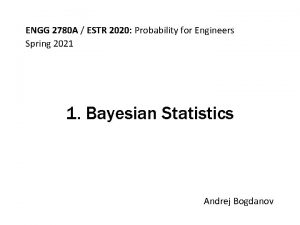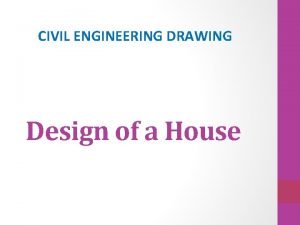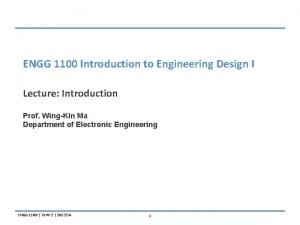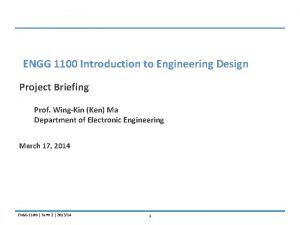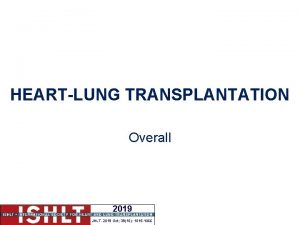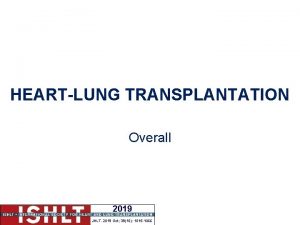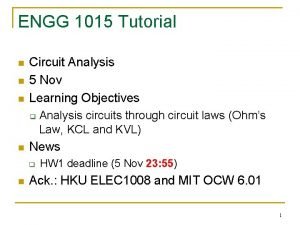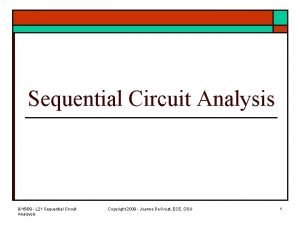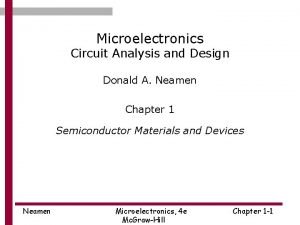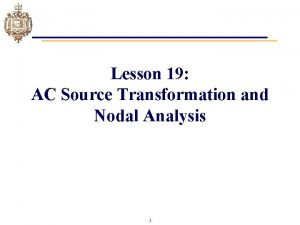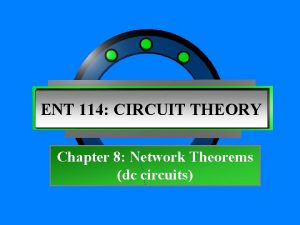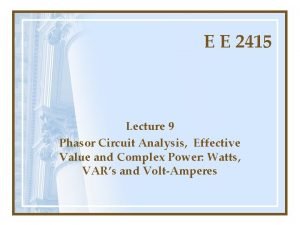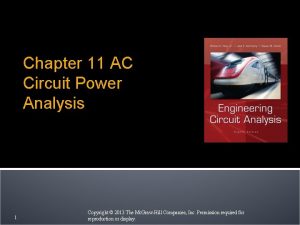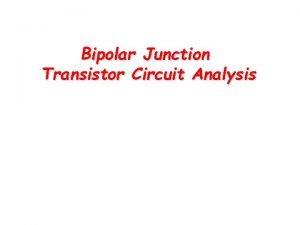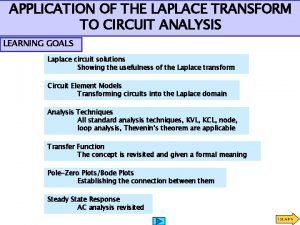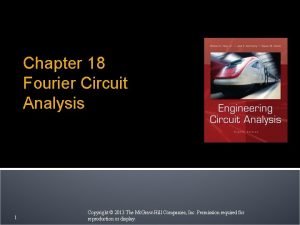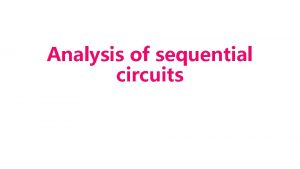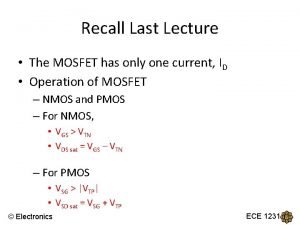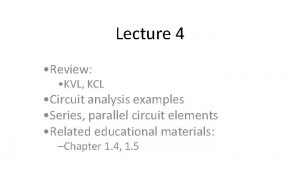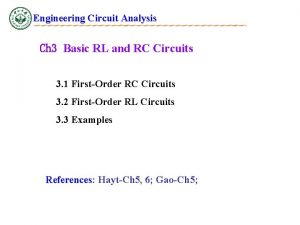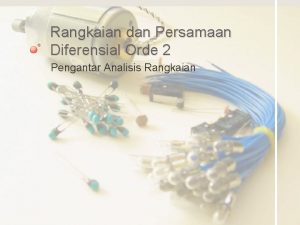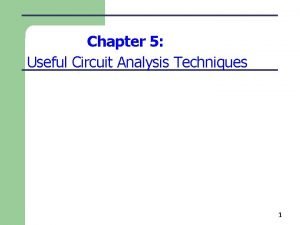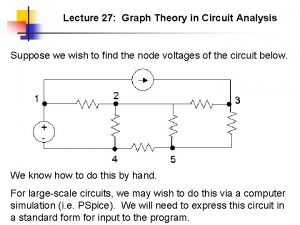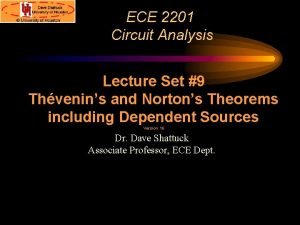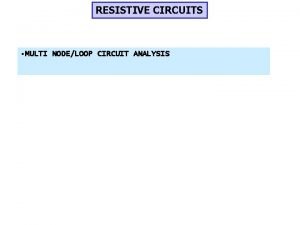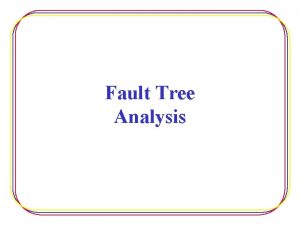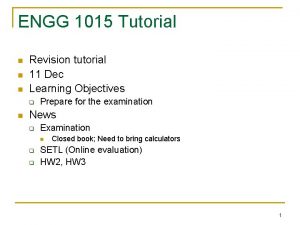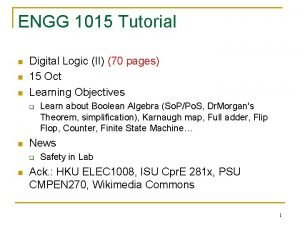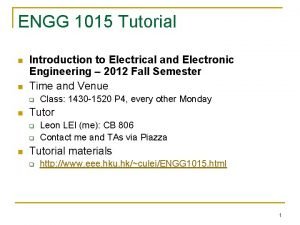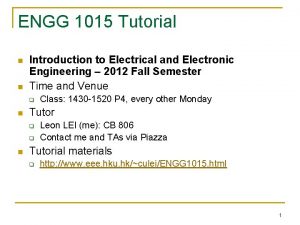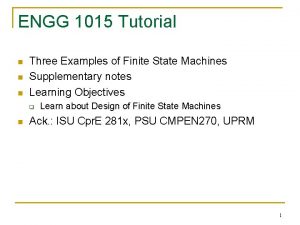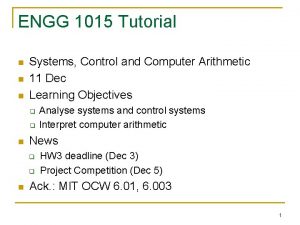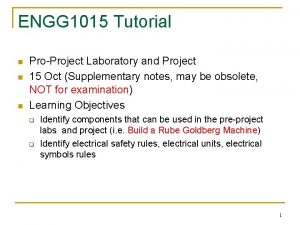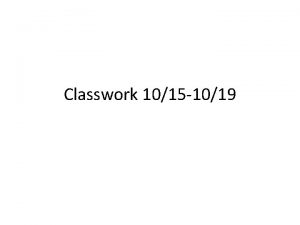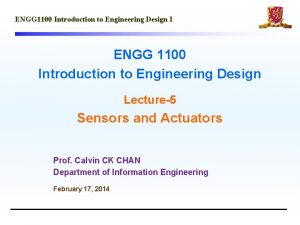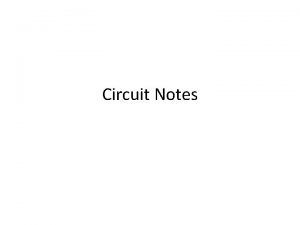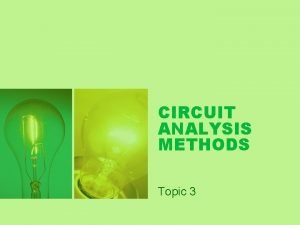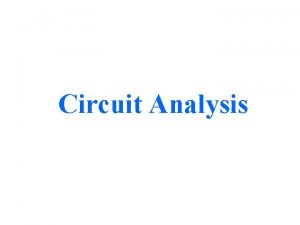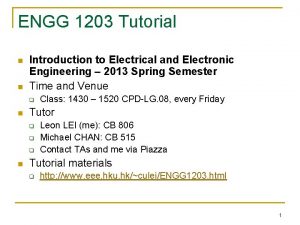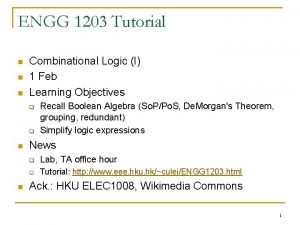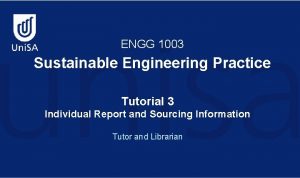ENGG 1015 Tutorial n n n Circuit Analysis










































- Slides: 42

ENGG 1015 Tutorial n n n Circuit Analysis 5 Nov Learning Objectives q n News q n Analysis circuits through circuit laws (Ohm’s Law, KCL and KVL) HW 1 deadline (5 Nov 23: 55) Ack. : HKU ELEC 1008 and MIT OCW 6. 01 1

Quick Checking NOT Always always True true If If , then 2

What is a Circuit? n Circuits are connects of components q q Through which currents flow Across which voltages develop 3

Rules Governing Flow and Voltages n Rule 1: Currents flow in loops q n Rule 2: Like the flow of water, the flow of electrical current (charged particles) is incompressible q n The same amount of current flows into the bulb (top path) and out of the bulb (bottom path) Kirchoff’s Current Law (KCL): the sum of the currents into a node is zero Rule 3: Voltages accumulate in loops q Kirchoff’s Voltage Law (KVL): the sum of the voltages around a closed loop is zero 4

Rules Governing Components n n Each component is represented by a relationship between the voltage (V) across the component to the current (I) through the component Ohm’s Law (V = IR) q R: Resistance 5

Question 1: Current and Voltage n n If R = 0 ohm, I 1 = If R = 1 ohm, V 1 = 6

Solution 1 n n If R = 0 ohm, I 1 = 6 V/3 ohm = 2 A If R = 1 ohm, 7

Parallel/Series Combinations n To simplify the circuit for analysis Series Parallel 8

Voltage/Current Divider Voltage Divider Current Divider 9

Question 2 a: Voltage Calculation n Find V 2 usingle loop analysis q q Without simplifying the circuit Simplifying the circuit 10

Solution 2 a n Choose loop current n Apply KVL q n Replace V 2 by R 2 I Find V 2 11

Solution 2 b n n n Simplify the circuit with one voltage source and one resistor Req. = R 1 + R 2 + R 3 = 7 ohm Veq. = Vs 1 + Vs 2 + Vs 3 = -2 + 2 = 2 V I = Veq. / Req. = 2/7 A V 2 = 4/7 v 12

Question 3: Potential Difference n Assume all resistors have the same resistance, R. Determine the voltage v. AB. 13

Solution 3 n n Determine VAB We assign VG=0 14

Question 4: Current Calculation using Parallel/Series Combinations For the circuit in the figure, determine i 1 to i 5. 15

Solution 4 n We apply: q q (i) q V = IR Series / Parallel Combinations Current Divider (ii) (iv) 16

Solution 4 (v) (vii) 17

Question 5: Resistance Calculation using Parallel/Series Combinations Find Req and io in the circuit of the figure. 18

Solution 5 (i) (ii) 19

Solution 5 (iii) 20

Analyzing Circuits n Assign node voltage variables to every node except ground (whose voltage is arbitrarily taken as zero) Assign component current variables to every component in the circuit Write one constructive relation for each component in terms of the component current variable and the component voltage Express KCL at each node except ground in terms of the component currents Solve the resulting equations n Power = IV = I 2 R = V 2/R n n 21

Question 6: Circuit Analysis (I) n n n R 1 = 80Ω, R 2 = 10Ω, R 3 = 20Ω, R 4 = 90Ω, R 5 = 100Ω Battery: V 1 = 12 V, V 2 = 24 V, V 3 = 36 V Resistor: I 1, I 2, …, I 5 = ? P 1, P 2, …, P 5 = ? 22

Solution 6 a n n VN = 0 I 1: M R 5 V 1 R 1 B I 2: M V 3 R 2 B I 4: M V 2 R 4 B Step 1, Step 2 23

Solution 6 a n n V M – V B = R 5 I 1 + V 1 + R 1 I 1 = (VM – VB – V 1)/(R 5 + R 1) = (24 – VB)/180 Step 3 24

Solution 6 a n n V N – V B = R 2 I 2 + R 3 I 2 = (VN – VB)/(R 2 + R 3) = – VB/30 Step 3 25

Solution 6 a n n n V M – V B = V 2 + R 4 I 4 = (VM – VB – V 2)/R 4 = (12 – VB)/90 We get three relationships now (I 1, I 2, I 4) Step 3 26

Solution 6 a n n KCL of Node B: I 1 + I 4 + I 2 = 0 (24 – VB)/180 + (12 – VB)/90 – VB/30 = 0 Step 4, Step 5 VB = 16/3 V 27

Solution 6 a n I 1 = n n (24 – VB)/180 = 14/135 A = 0. 104 A I 4 = (12 – VB)/90 = 2/27 A = 0. 074 A I 2 = – VB/30 = – 8/45 A = – 0. 178 A Step 5 28

Solution 6 a n n n P = I 2 R = P 1 = (0. 104)2 80 = 0. 86528 W P 4 = (0. 074)2 90 = 0. 49284 W = VR 42 / R (6. 66 V, 90Ω) 29

Solution 6 b Let’s try another reference ground n n VM = 0 I 1: B R 1 V 1 R 5 M I 2: B R 2 R 3 V 3 M I 4: B R 4 V 2 M 30

Quick Checking n I 1: n n n B R 1 V 1 R 5 M I 2: B R 2 R 3 V 3 M I 4: B R 4 V 2 M Different direction, different result? 31

Solution 6 b n n n KCL of Node B: I 1 + I 2 + I 4 = 0 V B – V M = R 1 I 1 – V 1 + R 5 I 1 = (VB – VM + V 1)/(R 1 + R 5) = (VB + 12)/180 32

Solution 6 b n n V B – V M = R 2 I 2 + R 3 I 2 – V 3 I 2 = (VB – VM + V 3)/(R 2 + R 3) = (VB + 36)/30 33

Solution 6 b n n V B – V M = R 4 I 4 – V 2 I 4 = (VB – VM + V 2)/R 4 = (VB + 24)/90 34

Solution 6 b n n KCL of Node B: I 1 + I 2 + I 4 = 0 (VB + 12)/180 + (VB + 36)/30 + (VB + 24)/90 = 0 VB = – 92/3 V 35

Solution 6 b n I 1 = n n (VB + 12)/180 = – 14/135 A = – 0. 104 A I 2 = (VB + 36)/30 = 8/45 A = 0. 178 A I 4 = (VB + 24)/90 = – 2/27 A = – 0. 074 A 36

Question 7: Circuit Analysis (II) n Find vo in the circuit of the figure. 37

Solution 7 n n Step 1: Define the node voltage (v 1, v 2, v 3) Step 2: Define the current direction 38

Solution 7 n n Apply: 1) V = IR 2) KCL Step 3: Consider node 1 39

Solution 7 n Step 3: Consider node 2 n Step 4, 5: From (1) and (2), v 1 = 30 V, v 2 = 20 V, v 0 = v 2 = 20 V 40

Quick Checking NOT Always always True true If If , then 41

Quick Checking NOT Always always True true If , then √ √ If , then √ 42
 Engg 2780
Engg 2780 Civil engg drawing house planning
Civil engg drawing house planning Engg 1100
Engg 1100 Engg 1100
Engg 1100 Jhlt. 2019 oct; 38(10): 1015-1066
Jhlt. 2019 oct; 38(10): 1015-1066 Jhlt. 2019 oct; 38(10): 1015-1066
Jhlt. 2019 oct; 38(10): 1015-1066 Jhlt. 2019 oct; 38(10): 1015-1066
Jhlt. 2019 oct; 38(10): 1015-1066 Jhlt. 2019 oct; 38(10): 1015-1066
Jhlt. 2019 oct; 38(10): 1015-1066 Vertical
Vertical Series vs parallel current
Series vs parallel current Parallel circuit with 3 bulbs
Parallel circuit with 3 bulbs Circuit construction kit
Circuit construction kit Current in series
Current in series Difference between complete and incomplete circuit
Difference between complete and incomplete circuit Diagram of short circuit
Diagram of short circuit Static vs current electricity venn diagram
Static vs current electricity venn diagram The circulatory system
The circulatory system Advantages of parallel circuits over series circuits
Advantages of parallel circuits over series circuits Analysis of sequential circuits
Analysis of sequential circuits Rangkaian sekuensial disebut juga
Rangkaian sekuensial disebut juga Pengantar analisis rangkaian
Pengantar analisis rangkaian Donald a. neamen
Donald a. neamen Source transformations
Source transformations Circuit theory theorems
Circuit theory theorems Phasor circuit analysis example
Phasor circuit analysis example Capacitor impedance laplace
Capacitor impedance laplace Ac circuit power analysis
Ac circuit power analysis Transistor large signal model
Transistor large signal model Laplace transform circuit analysis examples
Laplace transform circuit analysis examples Fourier series circuit analysis
Fourier series circuit analysis Analysis of sequential circuit
Analysis of sequential circuit Drain current formula in mosfet
Drain current formula in mosfet Linear circuit analysis
Linear circuit analysis Kcl equation examples
Kcl equation examples Sequential circuit analysis
Sequential circuit analysis Engineering circuit analysis
Engineering circuit analysis Rangkaian homogen
Rangkaian homogen Circuitos electricos 2
Circuitos electricos 2 Npn operation
Npn operation Abdcefgh
Abdcefgh Test source method circuit analysis
Test source method circuit analysis Resistive circuit analysis
Resistive circuit analysis Nasa fmea
Nasa fmea
